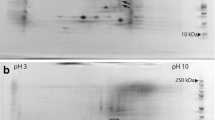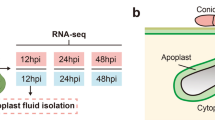Abstract
The xylem sap of a plant is primarily responsible for transporting molecules from the underground root system to the aboveground parts of the plant body. In order to understand the role that roots play in cotton growth and development, the components present in xylem sap must be elucidated. In this study, we used a shotgun HPLC-ESI-MS/MS proteomics approach to identify 455 peptides from the xylem sap of field-grown cotton plants at peak blooming stage. Of these peptides, 384 (84.4 %) were found to be secreted proteins and 320 (70.3 %) had special molecular functions. Based on Gene Ontology (GO) analysis, 348 peptides were annotated in terms of molecular function, biological process, and cellular localization, with 46.9 and 45.1 % being related to catalytic activity and binding activity, respectively. Many xylem sap-containing proteins were predicted to be involved in different phases of xylem differentiation including cell wall metabolism, secondary cell wall development and patterning, and programmed cell death. The identification of starch and sucrose hydrolyzing enzymes implicated the interaction between roots and aboveground parts on the aspect of carbohydrate metabolism. Many of the proteins identified in this study are involved in defense mechanisms including pathogen-related proteins, such as peroxidases, chitinases, and germin-like proteins, proteases involved in disease resistance, and phytoalexin phenylpropanoid synthesis-related proteins. The majority of identified signaling proteins were fasciclin-like arabinogalactan proteins and kinases. The results of this study provide useful insight into the communication mechanisms between cotton roots and the rest of the cotton plant.






Similar content being viewed by others
References
Agrawal GK, Jwa N-S, Lebrun M-H, Job D, Rakwal R (2010) Plant secretome: unlocking secrets of the secreted proteins. Proteomics 10(4):799–827
Albenne C, Canut H, Jamet E (2013) Plant cell wall proteomics: the leadership of arabidopsis thaliana. Frontiers in Plant Science 4:1–17
Alvarez S, Goodger JQD, Marsh EL, Chen S, Asirvatham VS, Schachtman DP (2006) Characterization of the maize xylem sap proteome. J Proteome Res 5:963–972
Alvarez S, Marsh EL, Schroeder SG, Schactman DP (2008) Metabolomic and proteomic changes in the xylem sap of maize under drought. Plant Cell Environ 31:325–340
Bacic A, Harris PJ, Stone BA (1988) Structure and function of plant cell walls. In: Preiss J (ed) The biochemistry of plants. Academic, New York, pp 297–371
Bendtsen JD, Jensen LJ, Blom N, Von Heijne G, Brunak S (2004) Feature-based prediction of non-classical and leaderless protein secretion. Protein Eng Des Selection 17(4):349–356
Bendtsen JD, Kiemer L, Fausboll A, Brunak S (2005) Non-classical protein secretion in bacteria. BMC Microbiol 5(1):58
Biles CL, Abeles FB (1991) Xylem sap proteins. Plant Physiol 96(2):597–601
Bollhöner B, Prestele J, Tuominen H (2012) Xylem cell death: emerging understanding of regulation and function. J Exp Bot. doi:10.1093/jxb/err438
Buhtz A, Kolasa A, Arlt K, Walz C, Kehr J (2004) Xylem sap protein composition is conserved among different plant species. Planta 219(4):610–618
Buist G, Steen A, Kok J, Kuipers OP (2008) LysM, a widely distributed protein motif for binding to (peptido) glycans. Mol Microbiol 68(4):838–847
Carpta NC, Gibeaut DM (1993) Structural models of primary cell walls in flowering plants: consistency of molecular structure with the physical properties of walls during growth. Plant J 3(1):1–30
Casasoli M, Spadoni S, Lilley KS, Cervone F, De Lorenzo G, Mattei B (2008) Identification by 2-D DIGE of apoplastic proteins regulated by oligogalacturonides in arabidopsis thaliana. Proteomics 8(5):1042–1054
Cheng FY, Blackburn K, Lin YM, Goshe MB, Williamson JD (2009) Absolute protein quantification by LC/MSE for global analysis of salicylic acid-induced plant protein secretion responses. J Proteome Res 8(1):82–93
Chivasa S, Simon WJ, Yu XL, Yalpani N, Slabas AR (2005) Pathogen elicitor-induced changes in the maize extracellular matrix proteome. Proteomics 5(18):4894–4904
Cho WK, Chen XY, Chu H, Rim Y, Kim S, Kim ST, Kim SW, Park ZY, Kim JY (2009) Proteomic analysis of the secretome of rice calli. Physiol Plant 135(4):331–341
Cosgrove DJ (1997a) Assembly and enlargement of the primary cell wall in plants. Annu Rev Cell Dev Biol 13:171–201
Cosgrove DJ (1997b) Relaxation in a high-stress environment: the molecular bases of extensible cell walls and cell enlargement. Plant Cell 9(7):1031–1041
Dafoe NJ, Constabel CP (2009) Proteomic analysis of hybrid poplar xylem sap. Phytochemistry 70(7):856–863
Delaunois B, Colby T, Belloy N, Conreux A, Harzen A, Baillieul F, Clément C, Schmidt J, Jeandet P, Cordelier S (2013) Large-scale proteomic analysis of the grapevine leaf apoplastic fluid reveals mainly stress-related proteins and cell wall modifying enzymes. BMC Plant Biol 13:24
Demura T, Tashiro G, Horiguchi G, Kishimoto N, Kubo M, Matsuoka N, Minami A, Nagata-Hiwatashi M, Nakamura K, Okamura Y, Sassa N, Suzuki S, Yazaki J, Kikuchi S, Fukuda H (2002) Visualization by comprehensive microarray analysis of gene expression programs during transdifferentiation of mesophyll cells into xylem cells. Proc Natl Acad Sci 99(24):15794–15799
Djordjevic MA, Oakes M, Li DX, Hwang CH, Hocart CH, Gresshoff PM (2007) The glycine max xylem sap and apoplast proteome. J Proteome Res 6(9):3771–3779
Floerl S, Druebert C, Majcherczyk A, Karlovsky P, Kües U, Polle A (2008) Defence reactions in the apoplastic proteome of oilseed rape (brassica napus var. napus) attenuate verticillium longisporum growth but not disease symptoms. BMC Plant Biology 8:129
Gaspar YM, Johnson KL, McKenna JA, Bacic A, Schultz CJ (2001) The complex structures of arabinogalactan-proteins and the journey towards understanding. Plant Mol Biol 47:161–176
Gens JS, Fujiki M, Pickard BG (2000) Arabinogalactan proteins and wall associated kinases in a plasmalemmal reticulum with specialized vesicles. Protoplasma 212:115–134
Guan Y, Nothnagel EA (2004) Binding of arabinogalactan proteins by yariv phenylglycoside triggers wound-like responses in arabidopsis cell cultures. Plant Physiol 135(3):1346–1366
Gust AA, Willmann R, Desaki Y, Grabherr HM, Nürnberger T (2012) Plant LysM proteins: modules mediating symbiosis and immunity. Trends Plant Sci 17(8):495–502
Houterman PM, Speijer D, Dekker HL, DE Koster CG, Cornelissen BJC, Rep M (2007) The mixed xylem sap proteome of fusarium oxysporum-infected tomato plants. Mol Plant Pathol 8(2):215–221
Ishihama Y, Sato T, Tabata T, Miyamoto N, Sagane K, Nagasu T, Oda Y (2005) Quantitative mouse brain proteomics using culture-derived isotope tags as internal standards. Nat Biotechnol 23(5):617–621
Jamet E, Albenne C, Boudart G, Irshad M, Canut H, Pont-Lezica R (2008) Recent advances in plant cell wall proteomics. Proteomics 8(4):893–908
Kehr J, Buhtz A, Giavalisco P (2005) Analysis of xylem sap proteins from Brassica napus. BMC Plant Biology 5:11
Ligat L, Lauber E, Albenne C, Clemente HS, Valot B, Zivy M, Pont-Lezica R, Arlat M, Jamet E (2011) Analysis of the xylem sap proteome of Brassica oleracea reveals a high content in secreted proteins. Proteomics 11(9):1798–1813
Liu JS, Zheng SC, Liu L, Li L, Feng QL (2010) Protein profiles of the midgut of spodoptera litura Larvae at the sixth instar feeding stage by shotgun ESI-MS approach. J Proteome Res 9:2117–2147
Minic Z (2008) Physiological roles of plant glycoside hydrolases. Planta 227(4):723–740
Nielsen H, Engelbrecht J, Brunak S, von Heijne G (1997) Identification of prokaryotic and eukaryotic signal peptides and prediction of their cleavage sites. Protein Eng 10(1):1–6
Nombela C, Gil C, Chaffin WL (2006) Non-conventional protein secretion in yeast. Trends Microbiol 14(1):15–21
Oda Y, Fukuda H (2013) Spatial organization of xylem cell walls by ROP GTPases and microtubule-associated proteins. Curr Opin Plant Biol 16(6):743–748
Oda Y, Hasezawa S (2006) Cytoskeletal organization during xylem cell differentiation. J Plant Res 119(3):167–177
Oda A, Sakuta C, Masuda S, Mizoguchi T, Kamada H, Satoh S (2003) Possible involvement of leaf gibberellins in the clock-controlled expression of XSP30, a gene encoding a xylem sap lectin, in cucumber roots. Plant Physiol 133(4):1779–1790
Passardi F, Penel C, Dunand C (2004) Performing the paradoxical: how plant peroxidases modify the cell wall. Trends Plant Sci 9:534–540
Rep M, Dekker HL, Vossen JH, de Boer AD, Houterman PM, Speijer D, Back JW, de Koster CG, Cornelissen BJC (2002) Mass spectrometric identification of isoforms of PR proteins in xylem sap of fungus-infected tomato. Plant Physiol 130(2):904–917
Rep M, Dekker HL, Vossen JH, de Boer AD, Houterman PM, de Koster CG, Cornelissen BJC (2003) A tomato xylem sap protein represents a new family of small cysteine-rich proteins with structural similarity to lipid transfer proteins. FEBS Lett 534:82–86
Sakuta C, Satoh S (2000) Vascular tissue-specific gene expression of xylem sap glycine-rich proteins in root and their localization in the walls of metaxylem vessels in cucumber. Plant Cell Physiol 41(5):627–638
Salazar MM, Nascimento LC, Camargo ELO, Gonçalves DC, Neto JL, Marques WL, Teixeira PJPL, Mieczkowski P, Mondego JMC, Carazzolle MF, Deckmann AC, Pereira GAG (2013) Xylem transcription profiles indicate potential metabolic responses for economically relevant characteristics of Eucalyptus species. BMC Genomics 14:201–213
Satoh S (2006) Organic substances in xylem sap delivered to above-ground organs by the roots. J Plant Res 119(3):179–187
Shabab M, Shindo T, Gu C, Kaschani F, Pansuriya T, Chintha R, Harzen A, Colby T, Kamoun S, van der Hoorn RAL (2008) Fungal effector protein AVR2 targets diversifying defense-related Cys proteases of tomato. Plant Cell 20(4):1169–1183
Subramanian S, Cho U-H, Keyes C, Yu O (2009) Distinct changes in soybean xylem sap proteome in response to pathogenic and symbiotic microbe interactions. BMC Plant Biology 9:119
Taliercio EW, Romano G, Scheffler J, Ayre BG (2009) Expression of genes associated with carbohydrate metabolism in cotton stems and roots. BMC Plant Biology 9:11
Tan L, Showalter AM, Egelund J, Hernandez-Sanchez A, Doblin MS, Antony B (2012) Arabinogalactan-proteins and the research challenged for these enigmatic plant cell surface proteoglycans. Front Plant Sci 3:1–10
The Arabidopsis Genome Initiative (2000) Analysis of the genome sequence of the flowering plant arabidopsis thaliana. Nature 408:796–815
Ulker B, Somssich IE (2004) WRKY transcription factors: from DNA binding towards biological function. Curr Opin Plant Biol 7:491–498
Van der Hoorn RAL, Jones JDG (2004) The plant proteolytic machinery and its role in defence. Curr Opin Plant Biol 7(4):400–407
Van Loon LC, van Strien EA (1999) The families of pathogenesis related proteins, their activities, and comparative analysis of PR-1 type proteins. Physiol Mol Plant Pathol 55(2):85–97
Wan J, Zhang XC, Neece D, Ramonell KM, Clough S, Kim SY, Stacey MG, Stacey G (2008) A LysM receptor-like kinase plays a critical role in chitin signaling and fungal resistance in arabidopsis. The Plant Cell 20(2):471–481
Wang Y, Li B, Du MW, Eneji AE, Wang BM, Duan LS, Li ZH, Tian XL (2012) Mechanism of phytohormone involvement in feedback regulation of cotton leaf senescence induced by potassium deficiency. J Exp Bot 63(16):5887–5901
Wisniewski JR, Zougman A, Nagaraj N, Mann M (2009) Universal sample preparation method for proteome analysis. Nat Methods 6(5):359–362
Xia Y (2004) Proteases in pathogenesis and plant defence. Cell Microbiol 6(10):905–913
Zhang ZY, Tian XL, Duan LS, Wang BM, He ZP, Li ZH (2007) Differential responses of conventional and Bt-transgenic cotton to potassium deficiency. J Plant Nutr 30:659–670
Zhang ZY, Zhang X, Wang SF, Xin WW, Tang JX, Wang QL (2013) Effect of mechanical stress on cotton growth and development. PLoS ONE 8(12):e82256. doi:10.1371/journal.pone.0082256
Acknowledgment
This research was supported by the National Natural Science Foundation of China (31271648) and the Science and Technology Innovation Talents Project of Henan Province of China (114100510008). This research was also supported by the National High Technology Research and Development Program of China (Program 863) (2011AA10A102), the Industry Technology System of Cotton in Henan China (S2013-07) and the National Genetically Modified Organisms Breeding Technology Major Projects of China (2014ZX08005-002).
Author information
Authors and Affiliations
Corresponding author
Electronic supplementary material
Below is the link to the electronic supplementary material.
ESM 1
(DOC 268 kb)
Rights and permissions
About this article
Cite this article
Zhang, Z., Xin, W., Wang, S. et al. Xylem sap in cotton contains proteins that contribute to environmental stress response and cell wall development. Funct Integr Genomics 15, 17–26 (2015). https://doi.org/10.1007/s10142-014-0395-y
Received:
Revised:
Accepted:
Published:
Issue Date:
DOI: https://doi.org/10.1007/s10142-014-0395-y




